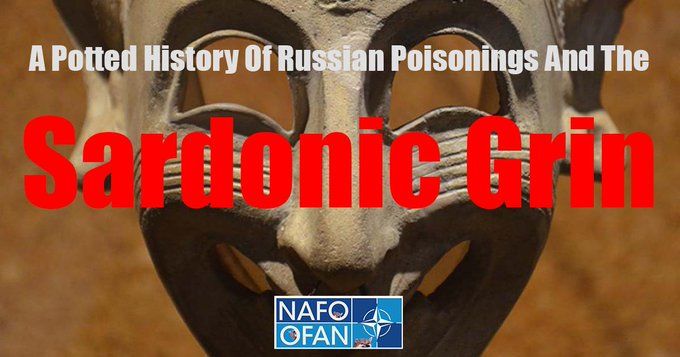Subtler forms of liquidation had been in the works for some time in Soviet Russia. In 1921—the year Sudoplatov was recruited at age 14 into the Cheka, the Soviet security organization formed by Vladimir Lenin—the Soviets established their first laboratory for the study and testing of poisons.
They made rapid progress. From 1928–35 secret laboratories were overseen by the accomplished Soviet biochemist Grigory Mairanovsky. The author of a 1940 classified doctoral thesis on the interaction of mustard gas with human skin, Mairanovsky was tasked to develop tasteless, colorless, odorless, and lethal poisons that could be placed in the food and drink of enemies of the state. Mairanovsky and his colleagues tested their concoctions on political prisoners of various sizes and ages.
He was so successful that by the 1940s he had become a key member of Pavel Sudoplatov’s team for political assassinations. In summer 1947, again on the order of Stalin, Mairanovsky killed the American spy for the Soviets Isaiah Oggins by injecting him in one of his laboratories with a lethal dose of the poison curare.
Poisoning has a long history. Socrates was forced to take hemlock as his death sentence. For a period of time in ancient Persia, different poisons were the weapons of choice for rivals bent on doing away with this or that Persian king. British science writer John Emsley provides a helpful history of poison in his riveting book.
In 19th-century France, arsenic came to be known as poudre de succession—”inheritance powder,” a method by which wily women would rid themselves of cumbersome husbands. Thallium, according to Emsley, was Saddam Hussein’s poison of choice for political opponents.
Russians have always seemed to have a special fondness for poisoning. In 1453, Dmitry Shemyaka, the Grand Duke of Moscow, was poisoned with arsenic in a chicken dinner, his cook having been bribed by Muscovite agents of a rival.
In 1610, Russian general Mikhail Skopin-Shuisky was poisoned on orders of the Tsar; in this instance, his wife enlisted to poison his food. In 1936, Abkhaz Communist leader Nestor Lakoba was poisoned by orders of Lavrentiy Beria, head of the NKVD, the Soviet security organization responsible for extrajudicial killings and the gulag system. Lakoba was poisoned during a dinner in Tbilisi with Beria, his death announced as a heart attack.
During the Cold War, the tradition continued. Most spectacular and famous is the case of Georgi Markov, an anti-communist Bulgarian writer who in exile had worked for Radio Free Europe and the BBC. On the morning of September 7, 1978—the birthday of Bulgarian dictator Todor Zhivkov—Markov made his way across Waterloo Bridge in London to wait for a bus.
An assassin, working for the Bulgarian secret police and aided by the KGB, poked Markov with the tip of his umbrella. By evening, Markov was checked into a hospital, feeling unwell with a high fever. Four days later he was dead.
Forensic pathologists discovered a pellet filled with traces of ricin in the back thigh of Markov’s right leg. According to former Russian intelligence officer Boris Volodarsky in his book, , Markov had likely been surveilled before the assassination by another Bulgarian BBC broadcaster named Vladimir Simeonov.
Twenty days after Markov’s murder—and two days after being questioned by Scotland Yard—the 30-year-old Simeonov was himself found dead under mysterious circumstances. In the kitchen of his flat, reports Volodarsky, “two glasses were found in the sink without any fingerprints. Traces of a bottle were identified on the table.
A decade earlier, Alexander Dubcek, the reform communist leader of the ill-fated Prague Spring, was thought in Czech anti-Communist circles to have been poisoned by the KGB, in this instance by radioactive isotopes sneaked into his soup during a brief captivity in Moscow. Dubcek fell ill later in Bratislava, had to cancel a speech, and was hospitalized due to “a cold.” He recovered.
As in the case of Pavel Sudoplatov’s detonating chocolates in Rotterdam, surreptitious poisoning gets trumped at times in Russian political assassinations by a somewhat heavier hand. In 1940, at his compound outside Mexico City, Russian revolutionary Leon Trotsky was fatally wounded by an ice-axe-wielding assassin (whose murder was ordered by Stalin and carried out under the direction of Sudoplatov).
And there was no poison involved in the murder this winter of Kremlin critic and former Deputy Prime Minister Boris Nemtsov. Shortly before midnight on February 27, walking after dinner with his Ukrainian girlfriend, Anna Durytska, across the Bolshoy Moskvoretsky Bridge close to Red Square, Nemtsov had four shots pumped into his back at close range from an assassin’s handgun.
Which brings us to the case at hand. At this writing, Nemtsov’s associate, journalist and civil society activist Vladimir Kara-Murza, lies ill in a Moscow hospital, according to reports stricken by kidney failure, double pneumonia, and pancreatitis. The 33-year-old Kara-Murza fell suddenly ill and collapsed in his Moscow office on May 26.
The day before, the organization for which Kara-Murza currently works (Open Russia, which was created in September 2014 by former political prisoner and Russian businessman Mikhail Khodorkovsky) had released a documentary about Ramzan Kadyrov, the ruthless ruler of Chechnya and a close ally of Russian President Vladimir Putin.
No one can say for sure at this point whether Kara-Murza has been poisoned. What we do know is that Russia has a ghastly tradition of poisoning political dissidents. We also know that very recent history has been alarming.
Although he survived—his face disfigured—pro-Western Ukrainian Presidential candidate Viktor Yushchenko was poisoned with dioxin at a dinner in Kiev during an election campaign in September 2004.
Former FSB man and Putin opponent Alexander Litvinenko died of polonium ingested in a London hotel bar in 2006. Russian businessman Alexander Perepilichny, a key witness in a Moscow money laundering case, expired outside his Surrey home in London in 2012, apparently having been killed by poison from the highly toxic Gelsemium plant (grown remote areas of China).
Then there’s the case of journalist and Putin critic Anna Politkovskaya. She was shot to death by assassins in the elevator to her apartment on October 7, 2006. But in September 2004, Politkovskaya had become violently ill and lost consciousness after drinking tea on a Russian flight.
With the history of poisonings in Russia, one is curious about one of the preferred methods used by the russians. Here’s an intro into just one such commonly found poison…

болиголов - AKA - Dropwort, Hemlock Water
The plant species Conium maculatum (hemlock, poisonous hemlock) is one of the most toxic members of the plant kingdom. There are numerous reports of deaths for a wide range of animal species including humans.
Conium maculatum has a worldwide distribution; it is a very common plant species, a member of the family Apiaceae (formerly Umbelliferae), the carrot family.
Poison hemlock is native to northern Europe, western Asia, and North Africa and it was introduced to North America as an ornamental back in the 1800s. Over time, this weed has spread throughout America, Mexico, and Canada.
Poison Hemlock, is a member of the plant family Apiaceae, which contains a few important crops such as carrots, celery, and parsnips. This weed is a tall, invasive, and highly poisonous weed that is sometimes mistaken for one of its crop relatives. It is also commonly mistaken for Queen Anne's Lace (Daucus carota).
Poison hemlock is toxic to humans and to livestock if ingested by affecting the respiratory, central nervous, and reproductive systems.
Some humans and animals can experience dermatitis on the skin just by coming into direct contact with this weed due to the potency of the eight alkaloids that contribute to its toxicity. All parts of this plant are poisonous and can be fatal to livestock and humans if ingested.
Among all the wild plants and weeds flourishing in this year’s wet weather, hemlock is making a disconcerting appearance. This is the highly poisonous plant that was used in the death sentence of the Greek philosopher Socrates in 399BC after he was found guilty of corrupting young minds through his teaching.
And Agatha Christie used the plant to good effect in her novel Five Little Pigs, when coniine, the toxic component extracted from hemlock, is disguised in a glass of beer to kill the painter Amyas Crale.
Identification Poison hemlock is an erect biennial (flowering plant that takes two years to complete its life cycle) weed that can grow six to ten feet tall. During the first year, growth is limited to a rosette of dark green leaves. More growth is observed in the second year, where the plant develops branching and alternately arranged leaves on erect stems.
This erect plant has smooth, hollow stems that are covered with purple spots. During the reproductive stages, the flowers are white umbrella-like clusters that during June and July, turning to fruit that is small, flat, and grayish-green in color from August to September. The root system is a fleshy white, with a long and sometimes branched taproot. Distribution Found widely in the UK, it is also native to a large part of Europe and.. Russia.
Habitat: Very common in damp areas including marshes, lake, river and stream sides or along ditches. Can be found several metres inland from water sources. It is reported that the wet spring of 2024 has resulted in fantastic growth of Hemlock in native areas of Russia. Fancy that!
Hemlock - and the Sardonic Grin.
The term sardonic grin comes from the grisly practice in Phoenician Sardinia of disposing of criminals and old people using Hemlock Water Dropwort. The poison acts by constricting the muscles causing death by asphyxia which also causes a rictus like death grin, the sardonic grin.
So what was the first instance in which the deadly hemlock was used? And how does it relate to the creepy grin?

While the first answer is unknown, it has been discovered through archaeological research that hemlock has a long use in the toolbox of assassins and hired killers.
The poisonous hemlock was also used for other, less sadistic purposes, though in many ways it was still highly immoral. Hemlock was employed by the Phoenicians of ancient Sardinia as a way to forcibly "euthanize" the elderly. Interpret that as you will.
Most often, the herb was dropped in the drink of an elderly individual, and then when the effects of the poison took over, the person would be killed through varying methods—the most commonly reported from ancient records are deadly beatings, boulders to the head, etc. All the while, the uncomfortable grin likely sent the illusion of gratitude to the euthanizers.
While the extent to which hemlock was employed for the purposes of "easing" the deaths of the elderly is recorded, the opinion of the elders is left for debate. The writers of the records were younger, so even the transcripts that remain, which might dictate the views of their elders, are likely tainted.
Did the elderly agree to this poisonous form of "mercy killing"? Could it even be called a "mercy killing" if these instances were, in fact, sneak attacks? Did it begin as a way by which younger family members could gain control of lands and money?
And finally, if the tradition was widespread in Sardinia, was it a practice that was just accepted without argument by the populace as each individual aged?
One drop of the poisonous hemlock water-dropwort was enough to completely incapacitate the target—the victim's muscles would grow taut, making it impossible to move, and the unusually uncomfortable smile would spread across the victim's face.
Because of the "frozen" musculature, the face would remain like that. Meanwhile, the assassin would complete his or her murderous job.
The juice or the extract of Conium maculatum was allegedly administered to criminals, and was the lethal poison, which the Greek philosopher Socrates was condemned to drink (399 BC). The symptoms of poisoning were described by Plato (a pupil of Socrates).
The old Roman name of the plant was Cicuta, but this name was later applied (by Gesner, 1541) to another umbelliferous plant, Cicuta virosa (water hemlock).
Risus sardonicus or rictus grin is a highly characteristic, abnormal, sustained spasm of the facial muscles that appears to produce grinning. It may be caused by tetanus, strychnine poisoning, or Wilson's disease, and has been reported after execution by hanging.
The condition's name, associated with the Mediterranean island of Sardinia, derives from the appearance of raised eyebrows and an open "grin", which can appear sardonic or malevolent to the lay observer, displayed by those experiencing these muscle spasms.
The poisonous agents of Hemlock Conium maculatum contains piperidine alkaloids: coniine (2-propylpiperidine), N-methyl-coniine (1-methyl-2-propylpiperidine), conhydrine 2-(1-hydroxypropyl)-piperidine, pseudoconhydrine (5-hydroxypropyl)-piperidine (these are saturated piperidine alkaloids) and γ-coniceine (2n-propyl-1Δ-piperidine), a partially unsaturated one. Conhydrinone and N-methyl-pseudoconhydrine were later isolated (Leete and Olson, 1972; Roberts and Brown, 1981).
Fascinating subject - do you agree? I wonder if my followers in Russia could confirm the abundance of this plant after the wet spring of 2024?
Next - Support Beefy please!
Folks, I self-fund my equipment, research and subscription costs. I would appreciate your coffee support ! If you enjoy my threads, please help me keep the threads free, it takes just a few minutes to support my work on Patreon or BuymeACoffee - in any currency.
Informative, evidence lead research for the price of a few coffees!
Thank You! to those who have supported me on Patreon or buymeacoffee, you are simply awesome.

















